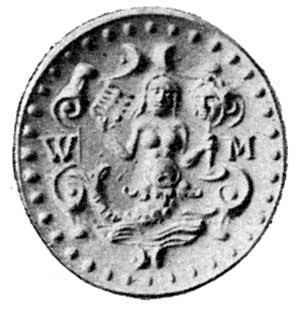< Previous
Note on a 16th Century Ring.
By Mr. W. H. Mason.

SIGNET RING FOUND AT EGMANTON.
IN February, 1916, Mr. J. R. Wardell, junior, of the Hall Farm, Egmanton, was walking over the grass field on the west side of his farm, when he noticed a freshly turned-up mole-hill; and turning it over with his foot he saw something glitter, and stooping down, he picked up a gold ring. The ring was almost covered with blue clay, which is the sub-soil there, and therefore it must have been thrown up from a considerable depth. The ring, which is a heavy seal-ring weighing as much as three sovereigns, has engraved on it the crest of the Mason family, viz.: a mermaid with a comb in her right hand and a looking-glass in her left. Round this figure is an ornamental shield, on one side of which is the initial letter W, and on the other side M. Clearly the ring was that of William Mason, who lived in the old Hall here towards the end of the 15th century.
The old Hall has long been pulled down. The site of it is about 400 yards east of the present hall farm, and is now under the plough. On it are to be found many fragments of brick and tiles, and pieces of pottery and earthenware.
William Mason married Julian, daughter of William Stringer, of Derby. The Stringers appear to have removed into Nottinghamshire about this time and are reckoned as a Nottinghamshire family, their pedigree being given by Thoroton, and also in the Herald's Visitations of this County. Julian's mother was a sister of Nicholas Poutrell, serjeant-at-law,1 whose monumental slab is in the chancel at Egmanton Church. It was from him that the Egmanton property came to William and Julian Mason.
William died at the old Hall, Norton Disney, in Lincolnshire, the residence of Daniel Disney, on November 30th, 1582, and was buried at Egmanton. His will, which is at York, was proved on March 29th, 1582-3. The Inquisitio post mortem was held at Newark on the day before March the 28th. It shews that William was possessed of considerable property in Nottinghamshire and Yorkshire. Several references to his dealings in land are to be found in Thoroton's History.
After his death, Julian married William Cardinall, of Neath Bromley, Essex, a member of the Queen's Council of the North, a body whose meetings were held at York. His will, which is at York, is dated January 26th, 1595-6, and was proved December 18th, 1598. There is a monument to him on the north wall of the nave of Egmanton Church. Julian, his widow, died at Egmanton, on November 6th, 1619, aged 62, and was buried there. Her will, which is at York and which is remarkable for a profession of her orthodoxy at prodigious length, is dated November 2nd, 1619, and was passed on March 16th, 1620-1. Her funeral certificate is in the College of Arms.
William and Julian Mason had seven children, of whom two died in infancy. Of the surviving children three were sons and two were daughters. There is nothing of general interest to record about any of these, except in the case of Edmund, the third son. He was educated at Pembroke College, Cambridge, was elected a Fellow in October, 1598, Bursar in 1610, and was Proctor in 1611. In 1598, being in Holy Orders, he took the living of Waresley in Huntingdonshire. He became successively Rector of Ordsall in 1614, Vicar of Newark in 1618, Rector of Cottenham in Cambridgeshire in 1628 and Dean of Salisbury in 1630. He was a Doctor of Divinity, Chaplain to James I., and tutor to Prince Charles, who was of course, afterwards Charles I. So perhaps he may be credited with having implanted in his pupil's mind the church principles which Charles so firmly held. A sermon of his, preached before the King at Oatlands on July 28th, 1622, was printed in that year, and copies of it may occasionly be met with. To the town of Newark he gave the black wand which is still in the possession of the Corporation.
He married a widow, who had several children by her first husband, but none by him. He died at his house in Petty France, Westminster, on March 24th, 1634-5, and was buried in the north transept of Westminster Abbey. No will having been made by him, administration was granted to his brother Thomas. His funeral certificate is in the College of Arms.
Thus a long story gathers round a little ring. But local history is only made up of small events in the lives of little known people, and every piece that we contribute goes towards fitting in the pattern of the mosaic.
< Previous
(1) Transactions 1902, p.80.
